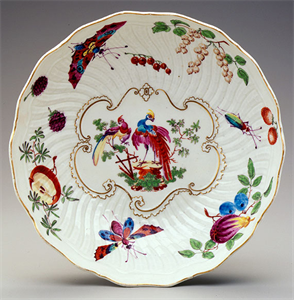
Worcester Porcelain Factory
English, born established 1751
Although much English porcelain is original in form and decoration, English manufactories in general were strongly influenced by their European competitors, particularly the factories at Meissen and Sevres, and especially during the third quarter of the eighteenth century. English and Continental manufactories considered themselves not only in direct competition with one another, but with the Far Eastern porcelain that was being imported during the eighteenth century. As a result, both English and Continental ceramic houses adopted Asian forms and decorative motifs, sometimes as direct copies, but more often as compilations of designs by a European artisan who had no understanding of the real significance of the original themes. In Worcester's case, as with other English ceramic houses, Asian motifs were more than likely filtered via the Continent rather than coming directly from Japan or China. As a result, the designs, called Chinoiseries, manifest the style without the substance of Oriental design, but also display an exotic charm.
Teaware was frequently decorated with pseudo-Oriental design, appropriate in light of the origins of tea in Far East. In the seventeenth century, tea was imported mainly from China, and only later did the varieties from India and Ceylon become readily available.
The origin of this popular pattern, called Chinese Family, is presumed to be Chinese export porcelain, although no exact Chinese counterpart is known. The design was made with a transfer-printed outline that was then colored in, like a child's coloring book. The pattern first appeared around 1765 and is found on teawares, always in conjunction with a border of loops and dots in red enamel (called a crowfoot border). Sometimes, as in this example, the red crowfoot border is filled in with a gold line.
Visual Splendors: First Period Worcester Porcelain from the Loeb Collection, 1997
English, born established 1751
Teapot and Cover
about 1765
Object Type:
Ceramic
Creation Place:
Northern Europe, English, Worcestershire
Dimensions:
5 1/2 in. x 7 in. x Diam: 4 1/4 in. (13.97 cm x 17.78 cm x 10.8 cm)
Medium and Support:
Porcelain
Accession Number:
1990.0009.0010 ab
Credit Line:
Gift of Mr. and Mrs. James Lucien Loeb
Currently On View
Although much English porcelain is original in form and decoration, English manufactories in general were strongly influenced by their European competitors, particularly the factories at Meissen and Sevres, and especially during the third quarter of the eighteenth century. English and Continental manufactories considered themselves not only in direct competition with one another, but with the Far Eastern porcelain that was being imported during the eighteenth century. As a result, both English and Continental ceramic houses adopted Asian forms and decorative motifs, sometimes as direct copies, but more often as compilations of designs by a European artisan who had no understanding of the real significance of the original themes. In Worcester's case, as with other English ceramic houses, Asian motifs were more than likely filtered via the Continent rather than coming directly from Japan or China. As a result, the designs, called Chinoiseries, manifest the style without the substance of Oriental design, but also display an exotic charm.
Teaware was frequently decorated with pseudo-Oriental design, appropriate in light of the origins of tea in Far East. In the seventeenth century, tea was imported mainly from China, and only later did the varieties from India and Ceylon become readily available.
The origin of this popular pattern, called Chinese Family, is presumed to be Chinese export porcelain, although no exact Chinese counterpart is known. The design was made with a transfer-printed outline that was then colored in, like a child's coloring book. The pattern first appeared around 1765 and is found on teawares, always in conjunction with a border of loops and dots in red enamel (called a crowfoot border). Sometimes, as in this example, the red crowfoot border is filled in with a gold line.
Visual Splendors: First Period Worcester Porcelain from the Loeb Collection, 1997
Keywords
Click a term to view the records with the same keyword
Additional Images
Click an image to view a larger version
Portfolio List
Click a portfolio name to view all the objects in that portfolio
This object is a member of the following portfolios:
Your current search criteria is: Portfolio is "Classification: Ceramic" and [Object]Display Artist is "Worcester Porcelain Factory".

 by Country (2)
by Country (2)

